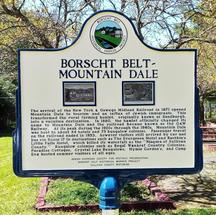 |
| Mountain Dale |
|
| Borscht Belt - Mountain Dale
The arrival of the New York and Oswego Midland Railroad in 1871 opened Mountain Dale to tourism and influx of Jewish immigrants. This transformed the rural farming hamlet, originally known as Sandburg, into a vacation destination. In 1880, the hamlet officially changed its name to Mountain Dale and the railroad became known as the O & W Railway. At its peak during the 1920s through the 1960s, Mountain Dale was to host about 34 hotels and 75 bungalow communities. Passenger travel on the railroad ended in 1953, however visitors still arrived by car and bus via Route 17 to destinations such as the Evergreen Hotel and Rashkinds Little Falls Hotel, which billed its waterfalls as "The Niagara of Sullivan County." Bungalow colonies such as the Regal Wankref Countries Colonies, Paradise Colonies, Crystal Lake Bungalows, Hymie Gordon's, and Camp Eva hosted summer summer visitors of all ages.
Side 2
Borscht Belt
From the 1920s through the early 1970s, the Borscht Belt was the preeminent summer resort destination for hundreds of thousands of predominantly east coast American Jews. The exclusionof the Jewish community from existing establishments in the 1920s drove Jewish entrepreneurs to create over 500 resorts, 50,000 bungalows and 1,000 rooming houses in Sullivan County and parts of Ulster County. The Borscht Belt provided a sense of community for working and vacationing Jews. The era exerted a strong influence on American culture, particularly in the realm of entertainment, music, and sports. Some of the most well-known and influential people of the 20th century worked and vacationed in the areas. Beginning around 1960, the Borscht Belt began a gradual demise due to many factors including the growth of suburbia, inexpensive airfare and generation changes.
Erected 2023 by Jewish American Society for Historic Preservation, the Borscht Belt Historical Marker Project, Sullivan County Historian.
|